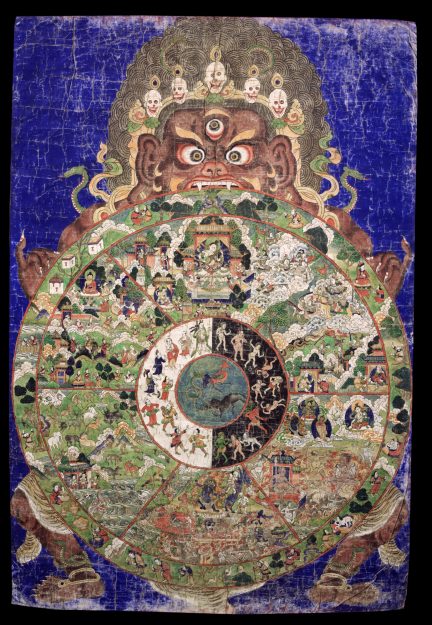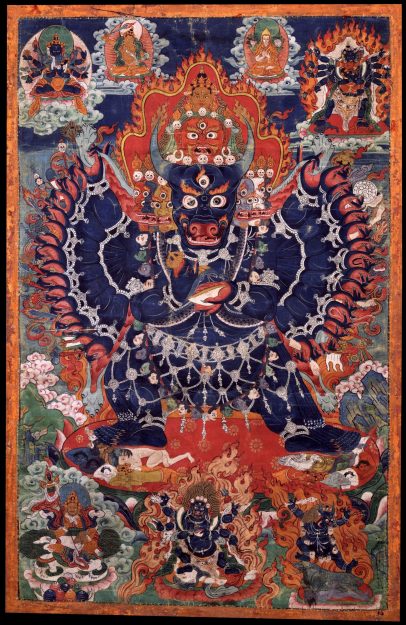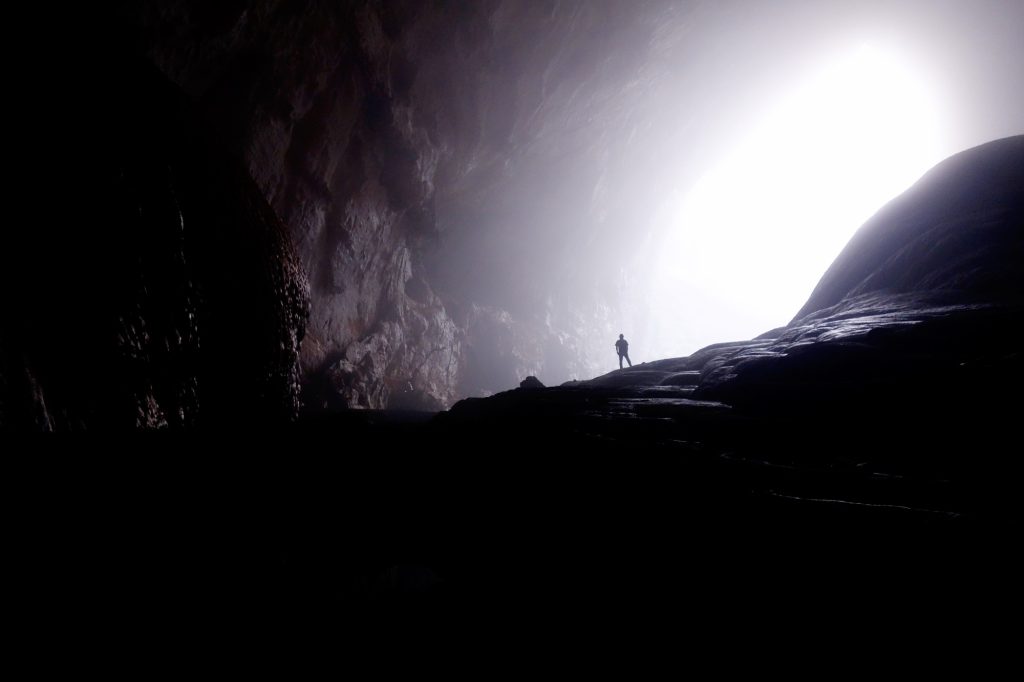Andrew Holecek teaches Living and Dying: Navigating the Bardos, an online course on the bardo teachings of Tibetan Buddhism. Bardo, meaning “gap” or “transition” can refer to any ending or change in life but often describes the journey that we make after death and before taking a new birth. In the following excerpt from the course, Holecek explains how looking into our fear of the dark can prepare us to face the unknown factors in our life and in death.
♦
I’m a spelunker of the mind. I love to explore the recesses of the darkness of mind and reality, because to me this is where all the goodies are. Many of us suffer from nyctophobia, a fear of the dark, which I believe is synonymous with thanatophobia, a fear of death. (Nyx was the Greek goddess of the night, and Thanatos was the god of death.) But I’m a nyctophiliac—I love the darkness.
If we lift up the rock, if we start to look at unconscious dimensions of mind and reality—we may discover things that are surprising to us. This is of considerable importance, because the darkness is associated with the unconscious mind, and as I’ll try to point out, unconscious processes dictate a large part of our so-called conscious lives.
This exploration of darkness also reveals to us a subtle and insidious discrimination. Whether we know it or not, we have a wake-centric bias, or wake-centricity. This is largely based on ego and egocentricity, because ego is only fully online and operational in the waking state and the alive state. When we fall asleep or when we die, this operating system goes offline.
We don’t go to another place when we die. We simply go to another dream.The wake-centric model is a somewhat clunky, outdated, and Western way of looking at things. The assumption that the only thing we can determine in terms of the nature of mind and reality is what we discover during the day restricts us. The great spelunkers of the mind, the spiritual masters from all the wisdom traditions, had the courage and the wherewithal—and the sophistication of their maps—to explore our deepest recesses. Therefore, they were able to penetrate the ultimate archetypical darkness, which is the darkness associated with death.
Darkness is a very convenient place to hide the things we’re afraid of: all our fears, our projections, and our rejected, un-processed, or unwanted experience. Unbeknown to us, darkness becomes laden with all our spiders and snakes. All the things we don’t want to face, we toss into the darkness of night, the darkness of the mind, and the darkness of death.
I am suggesting that your relationship to outer darkness—how comfortable you are with literal, physical outer darkness—is an indicator of how comfortable you are with inner darkness, the darkness that covers your heart.
How many lights do you need to leave on at night to feel comfortable? How many motion detectors do you have? How addicted are you to these light forms, especially artificial light, that tend to pull us out and away from what it is that we truly seek?
This is completely unfair to darkness because it is fundamentally neutral. But we attach to darkness all these fearful psychological aspects that are not inherent within it. And just as it’s unfair to burden darkness with all our fears, it’s unfair to death, which is similarly neutral. The end of life is as vibrant as today.
The Christian theological Barbara Brown Taylor puts this well in her book Learning How to Walk in The Dark. She writes, “Darkness is not dark to God. The night is as bright as the day.” I would take this a step further and say, “Death is not death to God.” (My definition of God—or the way I relate to this term—is the Buddhist and nontheistic fundamental awareness as it’s taught in the mystical traditions of India. The Kashmir Shaivist tradition, for instance, basically associate God with fundamental non-dual awareness.)
The [11th-century Tibetan Buddhist yogi] Milarepa explores this equanimous way of relating to this life and the next life in one of his beautiful songs of realization. Milarepa’s the amazing master who attained his complete awakening in one lifetime and became a mahasiddha, an adept who serves as an inspiration to others. He says, “Not seeing the here and here-after as differing, this is their nature as mastered as it can be.” In other words, if we see things properly, there is no fundamental difference between what occurs in this life and what occurs after life.
People often wonder, “Well, where do you go after you die?” According to the Buddhist tradition, we don’t go to another place when we die. We simply go to another dream. The question of where we go after death is completely reframed when we look at the nature of reality and the manifestation of mind as being dreamed. When we die, we don’t go to another ontological place; we simply transition from one dream to the next.
With the light of wisdom, death is as illuminated as the light of day. So we’re trying to illuminate the darkness of ignorance to eliminate the associated fear. We’re always afraid of what we don’t know. Fear, darkness, and ignorance are deeply intertwined, and the biggest reason we’re afraid of death is because we don’t know. We don’t understand the phenomenology of the death process, what the experience of death is like.
So how do we do this? The Tibetan Buddhist teachings on the bardos can be a flashlight to illuminate the darkness of ignorance, and therefore illuminate the fear. They can show us the trajectory of after-death experience or shed light on the unwanted experiences we have throughout our lives.
In the Tibetan tradition, there is also a practice called luminosity yoga, otherwise known as dream yoga, which puts forth that one can wake up and maintain awareness like in a lucid dreaming state. Lucid dreaming is when you’re aware that you’re dreaming during the dream. A text from the Kashmir Shaivist tradition says, “There is no darkness within. Only light unseen. Deep within you is this great eastern Sun that never sets.” This light within you is actually revealed in experiences like deep dreamless sleep and death.
We can also turn to the maps that past masters left us, such as the wheel of life and rebirth. We work with these images as ways to invoke, nurture, and cultivate inner qualities that are already within us. The figure of Yama holds the wheel. His name means restraint or death, the ultimate restraint on the freedom of all living beings. Yama represents death as well as the principle of mortality. His messengers are old age, sickness, and death, and he dispatches them into the world as a warning about the brevity of life. We want to befriend Yama. If we have an issue or are uncertain in our life, we can reframe the problem within his embrace and see if that contemplation changes the situation. How might we live differently if we realize that he’s not only walking at our side, he’s holding everything you do in your life?

Another important archetypal figure is Manjushri, the bodhisattva of wisdom. We can connect with him by reciting his mantra, Om A Ra Pa Ca Na Dhih, which I do almost every day as a way of cultivating incisive, precise awareness and intelligence. Manjushri’s wrathful form—wrathful cutting uncompromising wisdom—is Yamantaka, the destroyer of death. By establishing a relationship to him or her, we can unearth the archetype of Yamantaka within us. When we recite Yamantaka’s mantras, we evoke the quality of penetrating, wrathful wisdom, which sees through the illusion of death.

These are a few ways of looking at darkness, and this exploration is a study of origins. Everything arises in darkness. We’re conceived in the dark. You only have to go three millimeters below the skin and the entirety of your body is dark. We spend nine months in the dark, and before the big bang, there was darkness, according to some cosmological theories.
By exploring darkness and exploring death, we’re exploring endings as well as beginnings. Because laden within this darkness is light, and that’s fundamentally what we are trying to illuminate.
♦
Learn more about Andrew Holecek’s course, Living and Dying: Navigating the Bardos at learn.tricycle.org.
Thank you for subscribing to Tricycle! As a nonprofit, we depend on readers like you to keep Buddhist teachings and practices widely available.
